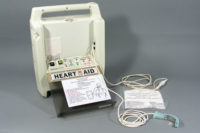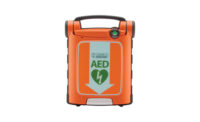
Your automated external defibrillator (AED) is one of the most important safety tools in your facility. In a cardiac emergency, it could save a life. Although not everyone can survive sudden cardiac arrest, studies show that early defibrillation can dramatically improve survival rates. For this reason it is important to evaluate the age and capabilities of your AEDs to determine if it is time for a replacement.
Age of device
There are currently two sources that regularly review depreciation of medical supplies. The American Hospital Association’s 2004 Estimated Useful Lives of Depreciable Hospital Assets lists the life expectancy of a defibrillator at five years. The Department of the Army Technical Bulletin (TB MED 7) lists life expectancy of a defibrillator at eight years.
Manufacturers typically discontinue products when parts become obsolete and are no longer available for service and repairs. If your warranty is expired, it can become cost-prohibitive to service or upgrade the unit. Check with your manufacturer for any take-back or trade-in discounts that can help offset the cost of replacement. When you decide it’s time to replace your AEDs, ask about the warranty period of your new devices. This is generally an indicator of the quality and reliability of the units.
Improved technology
Today’s equipment offers the following features that may render your current device obsolete:
- Biphasic waveforms: Biphasic waveforms are more effective than monophasic waveforms in converting chaotic heart rhythms to an organized heart rhythm. Because of their effectiveness, biphasic waveforms have become the standard of care, and defibrillators with monophasic waveforms are no longer manufactured. If you bought your unit before 2004, it is possible that it is a monophasic defibrillator.
- Escalating energy: The ability to escalate energy to 360J can improve shock success when lower energy shocks fail, giving difficult-to-defibrillate patients a better chance of survival. A recent analysis of the behavior of biphasic shocks from a large set of out-of-hospital cardiac arrest data showed defibrillation probability increased in parallel with each higher energy dose (82 percent at 200J, 86 percent at 300J, 90 percent at 360J) in patients who received shocks at each of the three energy levels. Clinical studies of both AF and VF show no evidence of cardiac damage with escalating energy to 360 joules. Because a defibrillator is an investment that lasts years, choosing one with full energy provides the flexibility to address evolving guidelines and protocols that reflect the latest understanding and research.
- Battery improvements: Battery technology has improved significantly in recent years. Older units often require large, bulky batteries that are expensive to replace. Batteries in current AEDs are typically small and lightweight, carry a higher capacity, and are less expensive on a per-year basis.
Improved usability
In order to save lives, AEDs must be properly used and maintained. The following features provide greater certainty that victims will get the help they need:
- Fully automatic shock: While all AEDs are designed to be user-friendly, fully automatic AEDs make it even easier for a responder to help a victim of sudden cardiac arrest and are designed to help responders who may hesitate to push the shock button. A fully automatic AED gives a shock automatically, if needed, without the user having to push a button. It also communicates clear, calm, step-by-step instructions that let responders know when a victim is about to be shocked. Two studies compared the behavior of untrained rescuers using a fully automatic or semi-automatic external defibrillator in a simulated cardiac arrest scenario. The first study found no difference in rescuer safety between a fully automatic and a semi-automatic device. The other study demonstrated that use of the fully automatic device resulted in fewer errors during shock delivery and reduced the time interval from the first shock to the third shock.
- Clear voice prompts and step-by-step instructions: Continual improvements in the quality and clarity of voice prompts are helping responders deploy the AED device and deliver CPR appropriately. For example, in both the 2005 and the 2010 AHA Guidelines, it is stated that after delivering a shock the AED should instruct the rescuer to resume CPR immediately, beginning with chest compressions. After the 2005 Guidelines were published, some manufacturers updated their AED device prompt to “Provide chest compressions and rescue breaths” to better align with the Guidelines. Visual indicators and voice prompt updates also instruct the responder in placing the electrode pads appropriately. Simple, step-by-step instructions are continually reviewed and updated based on user feedback and new AHA Guidelines. If you purchased your AED prior to 2005, you can improve responders’ ability to deliver lifesaving intervention by updating your AEDs to take advantage of the most advanced prompts and instructions.
- Ease of maintenance: To increase readiness assurance, today’s AEDs have indicators that notify you when the electrode pads are past the “use by” date and when the battery requires replacement. Additionally, a synchronized replacement schedule for pads and batteries can reduce the maintenance burden and help ensure that your units will always be supplied and ready for use.
- Compatibility: Coordination with your EMS agency is key to a successful AED program at your facility. Inquire about the brand of devices your local EMS teams use. Aligning your program with your local EMS helps streamline the transition of a patient from your facility to the ambulance to the hospital.
Resources
Stiell IG, Walker RG, Nesbitt LP, et al. Biphasic trial: A randomized comparison of fixed lower versus escalating higher energy levels for defibrillation in out-of-hospital cardiac arrest. Circulation. 2007; 115:1511-1517.
Walker RB, et al. Defibrillation probability and impedance change between shocks during resuscitation from out-of-hospital cardiac arrest. Resuscitation. 2009; 80:773-777. Neal S, et al. Comparison of the efficacy and safety of two biphasic defibrillator waveforms for the conversion of atrial fibrillation to sinus rhythm. Am J Cardiol. 2003; 92(7):810-14.
Hosmansa, T., Maquoia, I, Vogelsb, C, et al. Manikin and simulation study: Safety of fully automatic external defibrillation by untrained lay rescuers in the presence of a bystander. Resuscitation. 2008; 77:216-219.
Monsieursa, KG, Vogelsb, C, Bossaertc, LL, et al. A study comparing the usability of fully automatic versus semi-automatic defibrillation by untrained nursing students. Resuscitation. 2005; 64:41–47.
Author’s Note: AED users should be trained in CPR and use of the AED.






